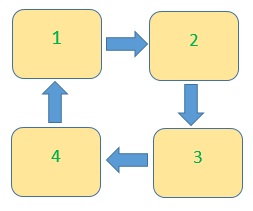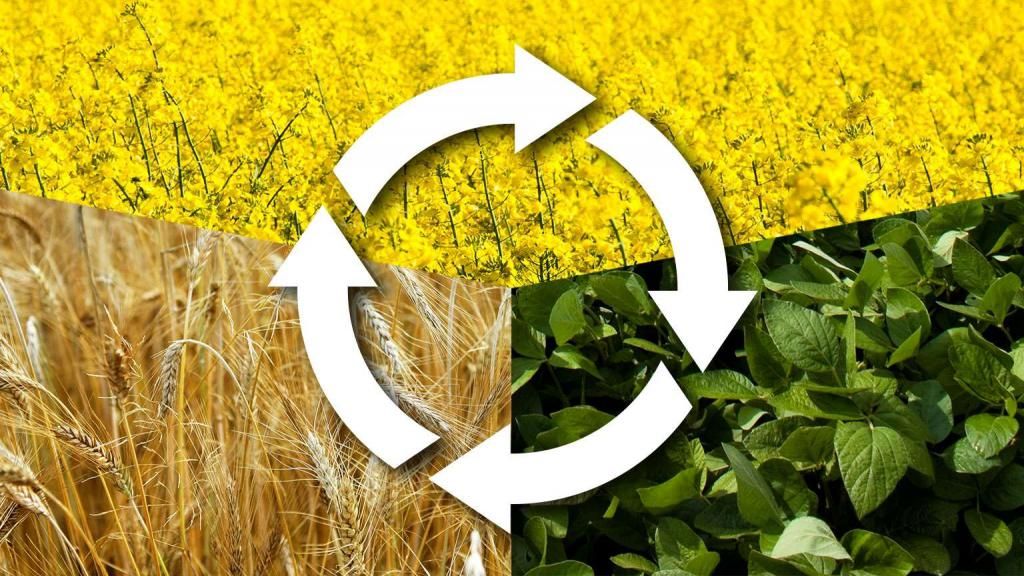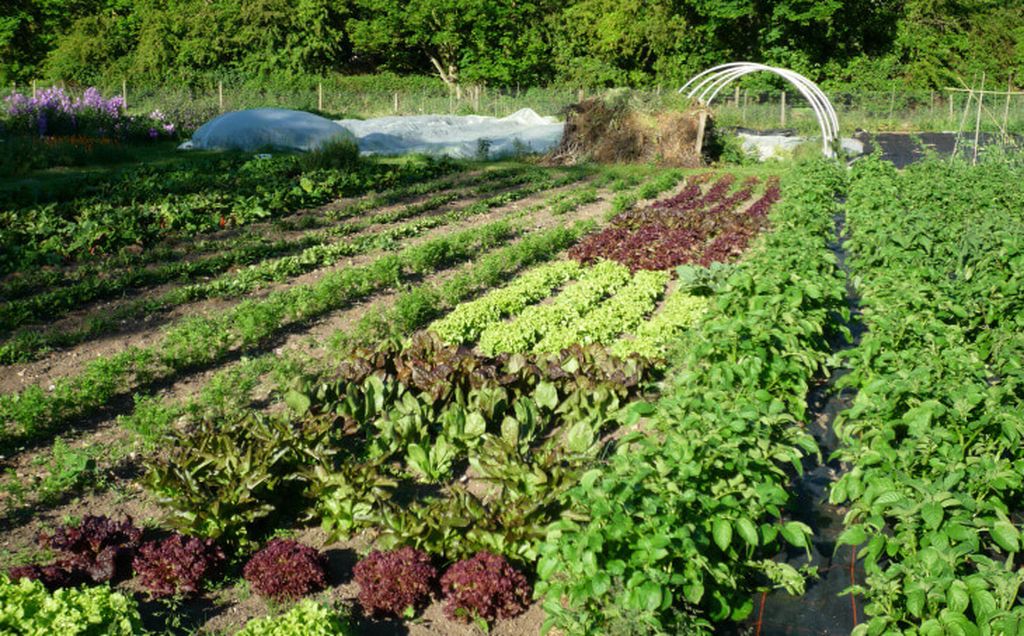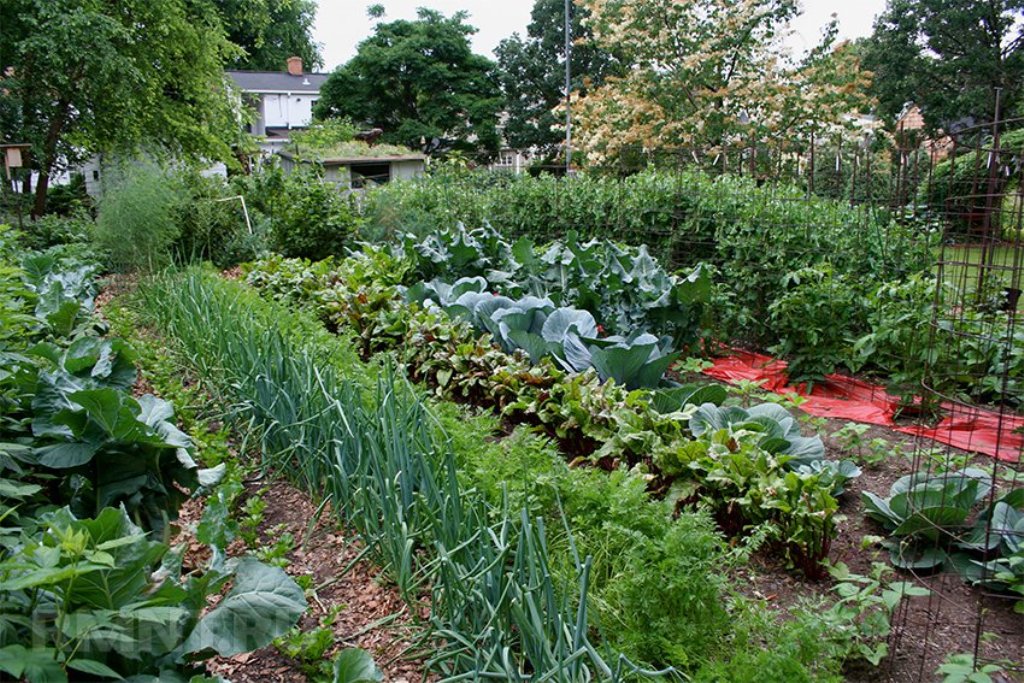Greetings, dear gardeners! We all want to get a big harvest every year from our summer cottage or garden, not just good, but straight. To what only magic methods gardeners do not come to achieve such a goal, only actions are sometimes not always environmentally friendly. As it turned out, there is no need to invent sophisticated schemes, everything has long been known. The most effective tool for high-quality growing vegetables is crop rotation. Rather, a competent crop rotation.
I tried to make the article as constructive and useful as possible for you, I made the classification and highlighted the features.
Table of contents
What gives the observance of crop rotation
4 reasons to observe the crop rotation on the site:
- you save the soil from exhaustion, since the same crop literally “eats away” all the useful substances every year, at the same depth of the soil;
- moreover, with proper crop rotation, the soil is saturated with useful elements;
- pests and diseases will not settle for a permanent place of residence, because each vegetable family has its own list of “edakov”, and if not to alternate cultures, then the pest populations will only increase;
- you can control fertilizers applied to the soil, each culture has its own preferences for fertility;
5 steps to get started:
- Make a list of the crops that you grow annually: tomatoes, potatoes, carrots, etc.
- examine the scale of your site and draw on paper the scheme of your possessions;
- to divide the plot into beds, at least 4-5, if meters and weave allow, then it is possible more;
- pick the right neighborhood of crops, if you want to plant more different vegetables, but the site does not allow, more on this later in the article);
- start and not be afraid to experiment, only at first it seems that there are so many nuances.
Principle
The principle of crop rotation works as follows, an example with respect to 4 beds.

Representatives of each group land on their beds. The next year we will make castling according to the scheme, and so in a circle for 4 years each culture will visit a new place. Next, note that some methods of crop rotation are divided into 4 groups for easy understanding, this will help to easily understand this simple lesson.
5 ways of crop rotation
Method 1
We alternate cultures in groups. All vegetable crops are divided into 4 groups (Table No. 1). Crop rotation is organized according to the scheme number 1.
Table number 1
| № | Groups of cultures | Representatives |
| 1 | Fruit | Cucumber, zucchini, tomato, pepper, pumpkin, eggplant |
| 2 | Leafy | Leafy salads, spinach, different types of cabbage, green onions |
| 3 | Legumes | Beans, chickpeas, peas |
| 4 | Roots | Beets, potatoes, carrots, radishes |
Method 2
Alternating cultures to the requirements of the soil.
Each vegetable crop requires a certain level of soil fertility. Table number 2 will give you a hint.
Table number 2
| № | Soil requirements | Family name |
| 1 | Undemanding | Umbrella, amaranth, amaryllis |
| 2 | Medium Demanding | Solanaceae |
| 3 | Demanding | Cabbage, asrovye, pumpkin |
| 4 | Enrich the soil | Legumes |
In Table 3, you will see which vegetables belong to which families.
Table number 3
| Family name | Culture name |
| Celery and umbrella | Dill, carrot, parsley |
| Pumpkin | Zucchini, pumpkin, cucumber, squash, melon, watermelon |
| Solanaceae | Tomato, potato, vegetable pepper, eggplant |
| Amaranths | Spinach, beets |
| Cruciferous or cabbage | Radish, cabbage, armchair |
| Cereals | Corn |
| Amaryllite | Garlic, onion |
| Legumes | Beans, peas |
| Astro | Lettuce, sunflower |
Method 3
We alternate vegetable crops by families.
Table number 4
| № | Family name |
| 1 | Umbrella |
| 2 | Solanaceae |
| 3 | Cabbage |
| 4 | Legumes |
| 5 | Pumpkin |
| 6 | Amaranths |
| 7 | Amaryllite |
| 8 | Astro |
If the size of the plot allows, then each family can be planted separately. And it is better to experiment with a profitable neighborhood of crops for greater yields, see Table 7 for this.
Method 4

We alternate cultures depending on their influence on the soil.
Table number 5
| 1 | Strongly deplete the soil | Beets, all kinds of cabbage, carrots |
| 2 | Moderately depleted | Pepper, zucchini, onion, tomato, eggplant |
| 3 | Weakly deplete | Salads, radishes, cucumber, spinach, peas |
| 4 | Enrich the soil | All legumes |
Crop rotation is organized according to the scheme number 1.
Method 5
Choose the best predecessor. This method is the most effective, but at the same time the most time-consuming. But for the sake of better harvest you should try it.
According to this method, the most important thing is to choose the predecessor culture correctly (which grew on this place last year). For convenience, I give below an exhaustive table.
Table number 6
| Potatoes - in most cases, grow as a monoculture, but in small areas, crop rotation is desirable. Planted in the same place in 2-3 years. | ||
| Best predecessor | Possible | Invalid |
| Siderats, cucumbers, cauliflower, beans, onions, early white cabbage, squash, garlic, pumpkin, zucchini. | Corn, carrot, greens, beet, cabbage of medium and late varieties, spice-flavored (basil, coriander) | Eggplant, pepper, tomatoes. |
| Eggplant | ||
| Best predecessor | Possible | Invalid |
| Garlic, melon, pumpkin, legumes, green mans, greens, zucchini,carrot, white cabbage of early varieties, squash, cauliflower, pickled onions (basil, coriander) | Corn, cabbage of an average and late grades, beet | Tomatoes, eggplants, peppers, early potatoes |
| Corn - as a monoculture in one place you can grow up to 10 years | ||
| Best predecessor | Possible | Invalid |
| Potatoes, pulses, beets | All cultures | Millet |
| Legumes (peas, chickpeas, beans) - serve as an excellent sideratom, it can be returned to its original place in 2-3 years | ||
| Best predecessor | Possible | Invalid |
| Garlic, garden strawberries, pumpkin, onions, early potatoes, squash, cabbage (all kinds), cucumbers, zucchini | Tomatoes, eggplants, siderats, greens, beets, carrots, peppers, spice-flavored (basil, coriander) | Corn, Bean |
| Cabbage - you can return to your original place in 2-3 years | ||
| Best predecessor | Possible | Invalid |
| Beans, legumes, siderats, zucchini, tomatoes, early potatoes (for middle and late varieties), cucumbers, carrots (for middle and late varieties), onions | Tomatoes, peas, lettuce, greens, peppers, eggplants | Pumpkin, radishes, cabbage, beets, cucumbers |
| Greens (onions on feathers, spinach, lettuce) and spice-flavored (basil, coriander), can be returned to their original place in 3-4 years | ||
| Best predecessor | Possible | Invalid |
| Garlic, legumes, pumpkin, cucumbers, siderata, zucchini, squash, early white cabbage, onions, cauliflower | Beetroot, eggplant, tomatoes, greens, spice cake, early potatoes, pepper, corn | Carrots, white cabbage, medium and late ripening |
| Radish - can be planted between rows | ||
| Best predecessor | Possible | Invalid |
| Garlic, pulses, strawberries potatoes, tomatoes, cucumbers, onions | Beets, eggplants, tomatoes, greens, peppers, corn, spice-cake | Carrots, cabbage |
| Zucchini - you can return to your original place in 2-3 years | ||
| Best predecessor | Possible | Invalid |
| Garlic, pulses, onions, potatoes, corn, early cabbage, cauliflower, parsley | Beetroot, bean, spistovkusovye, early potatoes, greens | Pumpkin, eggplant, tomatoes, white cabbage of medium and late varieties, pepper, carrot |
| Squash - you can return to your original place in 2-3 years | ||
| Best predecessor | Possible | Invalid |
| Corn, garlic, basil, onion, pulses, potatoes, cauliflower, early white cabbage | Beetroot, bean, spistovkusovye, early potatoes, greens | Pumpkin, eggplant, tomatoes, white cabbage of medium and late varieties, pepper, carrot |
| Onions - you can return to your original place in 3-4 years | ||
| Best predecessor | Possible | Invalid |
| Siderates, legumes, pumpkin, zucchini, cauliflower, squash, early potatoes, cucumbers, early white cabbage | Tomatoes, eggplants, beets, white cabbage of medium and late varieties, corn, pepper, garlic, onions | Spicy, carrots, greens |
| Pepper | ||
| Best predecessor | Possible | Invalid |
| Garlic, melon, pumpkin, legumes, siderata, greens, squash, zucchini, onions, cucumbers, early cabbage, carrots, cauliflower | Beetroot, cabbage of medium and late varieties, spice-cake, radish, corn | Tomatoes, pumpkin, eggplants, peppers, early potatoes |
| Carrot | ||
| Best predecessor | Possible | Invalid |
| Spice flavors, greens, squash, cabbage, onions, cucumbers, zucchini, early potatoes, pumpkin | Tomatoes, eggplants, beets, legumes, garlic, cabbage, radishes, corn, pepper, onions | Beet |
| Cucumber - you can return to your original place in 2-3 years | ||
| Best predecessor | Possible | Invalid |
| Garlic, pulses, onions, potatoes, corn, early cabbage, cauliflower, parsley | Spice-cake, beans, greens, beets, early potatoes | Tomatoes, eggplants, pumpkin, white and white cabbage of medium and late varieties, pepper, carrot |
| Beet canteen - you can return to your original place in 2-3 years | ||
| Best predecessor | Possible | Invalid |
| Siderata, greens, pumpkin, zucchini, spicy taste, onions, squash, cucumbers | Tomatoes, pulses, garlic, pepper, eggplants, corn, early cabbage, onions, cauliflower | Beets, potatoes, cabbage of medium and late varieties |
| Sunflower is a bad predecessor for almost all crops, it can be returned to its original place after 6-8 years | ||
| Best predecessor | Possible | Invalid |
| Corn, Bean | Potatoes | Beans, peas, beets, tomatoes |
| Garlic - it can be returned to its original place in 3-4 years | ||
| Best predecessor | Possible | Invalid |
| Siderates, legumes, pumpkin, zucchini, squash, early potatoes, cucumbers, early white cabbage, carrots, cauliflower | Garlic, eggplants, tomatoes, white cabbage of medium and late varieties, beets, onions, corn, pepper | Radish, greens, spicy flavor, carrots |
| Tomatoes - can grow as a monoculture, with a crop rotation it can be returned to its original place in 2-3 years | ||
| Best predecessor | Possible | Invalid |
| Siderats, basil, cucumbers, peas, carrots, greens, cauliflower, early white cabbage | Garlic, legumes, beets, white cabbage of medium and late ripening periods, spicy flavor, onions, corn | Tomatoes, eggplants, peppers, early potatoes |
| Garden strawberries - after potatoes, cucumbers and tomatoes can be grown in 3-4 years. | ||
| Best predecessor | Possible | Invalid |
| Dill, bean, garlic, onion, carrot, radish | Corn, cabbage | Tomatoes, cucumbers, potatoes |
| Pumpkin - you can return to your original place in 2-3 years | ||
| Best predecessor | Possible | Invalid |
| Garlic, legumes, parsley, potatoes, early white cabbage, onions, corn, cauliflower | Beetroot, bean, spistovkusovye, early potatoes, greens | Pumpkin, eggplant, tomatoes, white cabbage of medium and late varieties, pepper, carrot |
Method 6

The right neighborhood of cultures.All plants influence each other differently, so it is very important to know the most suitable neighborhood of crops in order to get high yields.
Proper placement can protect plants from pests, for example, the neighborhood of tomato with cabbage helps fight flea and leaf beetles. Moreover, this method helps to effectively plant even the most compact area.
Table number 7
| Zucchini | ||
| Best neighborhood | Possible | Invalid |
| Legumes, corn, greens | Spinach, eggplants, garlic, strawberries, sunflower, carrots | Radish, tomatoes, potatoes |
| Peas | ||
| Best neighborhood | Possible | Invalid |
| Cucumbers, carrots | Spinach, strawberry, dill, corn, beet, parsley, lettuce, radish | Garlic, beans, tomatoes, cabbage, onions, potatoes |
| Corn | ||
| Best neighborhood | Possible | Invalid |
| Beans, cucumbers, lettuce, tomatoes | Spinach, peas, garlic, strawberries, dill, cabbage, pumpkin, carrots, potatoes, radishes, onions | Beet |
| Leek | ||
| Best neighborhood | Possible | Invalid |
| Tomatoes, strawberries | Spinach, potatoes, garlic, cabbage, beans, corn, carrots, dill, cucumbers, beets, lettuce, radishes | Onions, peas |
| Eggplant | ||
| Best neighborhood | Possible | Invalid |
| Garlic, onion, beans, leek, greens | Cucumbers, strawberries, parsley | — |
| Onion | ||
| Best neighborhood | Possible | Invalid |
| Beets, Tomatoes, Carrots | Spinach, strawberries, garlic, potatoes, lettuce, corn, cucumbers, radishes | Beans, onions, peas, dill, cabbage |
| Cucumbers | ||
| Best neighborhood | Possible | Invalid |
| Beans, lettuce, legumes, dill, cabbage, beets, corn | Spinach, eggplants, garlic, strawberries, sunflower, carrots, onions | Tomatoes, potatoes, radishes |
| Cabbage | ||
| Best neighborhood | Possible | Invalid |
| Beans, strawberries, lettuce, carrots | Garlic, potatoes, spinach, corn, dill, leek | Parsley, peas, garlic, onions, tomatoes, cucumbers, beets, radishes |
| Squash | ||
| Best neighborhood | Possible | Invalid |
| Corn, greens, legumes | Garlic, strawberry, sunflower, carrot | Tomatoes, potatoes, radishes |
| Potatoes | ||
| Best neighborhood | Possible | Invalid |
| Spinach, beans | Spinach, strawberries, garlic, cabbage, dill, corn, lettuce, onions, radishes, carrots | Pumpkin, peas, beets, tomatoes, cucumbers |
| Sunflower | ||
| Best neighborhood | Possible | Invalid |
| — | Cucumbers | Potatoes |
| Perennial onions | ||
| Best neighborhood | Possible | Invalid |
| — | Tomatoes, parsley, strawberries, lettuce, carrots, radishes, cucumbers | Garlic, legumes |
| Radish | ||
| Best neighborhood | Possible | Invalid |
| Beans, carrots | Spinach, peas, garlic, strawberries, dill, cabbage, tomatoes, potatoes, beets, corn, lettuce, onions, radishes, parsley | Cucumbers, onions |
| Carrot | ||
| Best neighborhood | Possible | Invalid |
| Spinach, peas, onions, cabbage | Garlic, potatoes, tomatoes, corn, cucumbers, lettuce, radishes | Dill, beet, beans |
| Lettuce | ||
| Best neighborhood | Possible | Invalid |
| Corn, cabbage, cucumbers | Spinach, peas, garlic, strawberries, beans, potatoes, dill, onions, beets, tomatoes, carrots, radishes, parsley | — |
| Tomatoes | ||
| Best neighborhood | Possible | Invalid |
| Spinach, radish, corn, beans, carrots, beets, parsley | Garlic, onions, strawberries, lettuce, cabbage | Potatoes, peas, dill, cucumbers |
| Pepper | ||
| Best neighborhood | Possible | Invalid |
| Carrots, basil, onions | Parsley | Beans |
| Pumpkin | ||
| Best neighborhood | Possible | Invalid |
| Legumes, greens | Corn | Potatoes |
| Dill | ||
| Best neighborhood | Possible | Invalid |
| Cucumbers, cabbage | Spinach, peas, radish, garlic, strawberries, beans, potatoes, beets, corn, lettuce, leeks | Tomatoes, onions, carrots |
| Parsley | ||
| Best neighborhood | Possible | Invalid |
| Tomatoes, strawberries | Spinach, eggplants, lettuce, peas, radishes, leeks, peppers, perennial onions, cucumbers, carrots | Cabbage |
| Garlic | ||
| Best neighborhood | Possible | Invalid |
| — | Tomatoes, strawberries, beets, leeks, lettuce, carrots, radishes, cucumbers | Beans, peas, cabbage, onions perennial |
| Spinach | ||
| Best neighborhood | Possible | Invalid |
| Beans, strawberries, tomatoes, potatoes, beets, carrots | Peas, cabbage, onions, cucumbers, parsley, radishes, lettuce, dill, garlic | Beet |
| Beet | ||
| Best neighborhood | Possible | Invalid |
| Spinach, onion, beans, tomatoes | Garlic, peas, dill, strawberries, lettuce, cabbage, radishes, cucumbers | Carrots, potatoes, leeks, corn |
| Garden strawberries | ||
| Best neighborhood | Possible | Invalid |
| Spinach, parsley, cabbage, beans, carrots | Garlic, eggplants, dill, peas, tomatoes, potatoes, beets, corn, lettuce, onions, radishes, cucumbers | — |
| Beans | ||
| Best neighborhood | Possible | Invalid |
| Spinach, eggplants, beets, strawberries, radishes, cabbage, tomatoes, corn, cucumbers, potatoes | Dill, salad, spinach | Carrots, Peas, Garlic, Onions |
Who are siderata
TO sideratam leaf mustard, winter rye, pea, lupine, vetch. These cultures restore and enrich the soil with useful elements. It is possible to plant green manure, taking into account the organization of crop rotation, and in the time free from vegetables, for example, before winter.
Dear gardeners, I tried to give the most comprehensive information on the system of crop rotation in the form of checklists. All information is coordinated in the leaflets, save them, implement them in practice, and let the harvest come with us!
